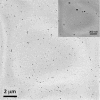Blue and green luminescent carbon nanodots from controllable fuel-rich flame reactors
- PMID: 31601923
- PMCID: PMC6787054
- DOI: 10.1038/s41598-019-50919-1
Blue and green luminescent carbon nanodots from controllable fuel-rich flame reactors
Abstract
The continuous synthesis in controlled gas flame reactors is here demonstrated as a very effective approach for the direct and easy production of structurally reproducible carbon nanodots. In this work, the design of a simple deposition system, inserted into the reactor, is introduced. A controlled flame reactor is employed in the present investigation. The system was optimized for the production of carbon nanoparticles including fluorescent nanocarbons. Blue and green fluorescent carbon could be easily separated from the carbon nanoparticles by extraction with organic solvents and characterized by advanced chemical (size exclusion chromatography and mass spectrometry) and spectroscopic analysis. The blue fluorescent carbon comprised a mixture of molecular fluorophores and aromatic domains; the green fluorescent carbon was composed of aromatic domains (10-20 aromatic condensed rings), bonded and/or turbostratically stacked together. The green-fluorescent carbon nanodots produced in the flame reactor were insoluble in water but soluble in N-methylpyrrolidinone and showed excitation-independent luminescence. These results provide insights for a simple and controlled synthesis of carbon nanodots with specific and versatile features, which is a promising pathway for their use in quite different applicative sectors of bioimaging.
Conflict of interest statement
The authors declare no competing interests.
Figures






References
-
- Shamsipur M, Barati A, Karami S. Long-wavelength, multicolor, and white-light emitting carbon-based dots: achievements made, challenges remaining, and applications. Carbon. 2017;124:429–472. doi: 10.1016/j.carbon.2017.08.072. - DOI
Publication types
LinkOut - more resources
Full Text Sources

